Mbira
Tunings from Zimbabwe
These
tuning diagrams are not meant to be taken as examples of
exact tunings of traditional African instruments. Rather,
the pitch names on the lamellae are meant to be a help to
Western musicians wishing to understand intervallic relationships
between traditional tunings in Zimbabwe and Western music
theory. Western pitch names used here are not absolute and
are for convenience only. Basically, in many of the traditional
Shona tunings for mbira dza vadzimu and karimba
the traditional intervals are often slightly stretched or
lowered when compared to Western ideas of being "in
tune." This is how these instruments are supposed to
be tuned and sound. However, if one were to play Shona music
on a traditionally tuned mbira dza vadzimu or karimba
and then on instruments that had the lamellae adjusted to
Western A=440, the resultant musical performances would
be recognizable as being generally the same. Traditionally,
African musicians prefer their tuning while Western musicians
wishing to perform with lamellaphones in Western contexts
sometimes adjust the tuning to A=440.
Some
feel that traditional instruments such as the matepe
feature a non-Western tuning in which the intervallic relationships
do not correspond to Western music theory. If one were to
"tune" the lamellae and play traditional music
on such an instrument, the resultant performance would not
be recognizable at all as the traditional music. However,
at least one researcher has given a matepe with
lamellae adjusted to Western A=440 to one of the top matepe
players (who made the adjusted instrument) who found the
tuning to be fine and that traditional material when played
upon this instrument to be recognizable. The matepe
tuning chart below is for an unadjusted instrument made
by Chaka Chawasarira.
The
terms Low, Medium, and High (also known as Kanyuchi)
have to do with range as to where a particular tuning is
pitched. The common pitch ranges for mbira found
today include the following: Mbira dza vadzimu
- Low: E & F (E most common); Medium: G, Ab, A, Bb &
B (A most common); High: C, D & E (C most common).
Karimba - High E, F, and A. Matepe / Hera
- Low F or F#.
Other
mbira tuning analyses from Zimbabwe and Mozambique
needed include mbira dza vadzimu in Mande
tuning and tuning for the instruments known as munyonga
(47, 52 & 56 lamellae), and ChiSanza (from
Mozambique, 22 lamellae). Other African lamellaphone tunings
soon to be posted include kondi from Sierra Leone,
sanza from Cameroon, and sanza from Central
African Republic.
These
charts are offered here for those who may have ordered mbira
through the mail and upon delivery have found that the tuning
has been lost (or unplayable) due to transit. Upon following
the diagrams below, you will be able to restore your instrument
to the point of being able to play traditional sounding
repertoire but will have lost the instrument's exact traditional
regional tuning characteristics.
Karimba
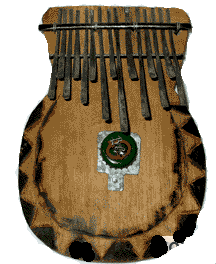
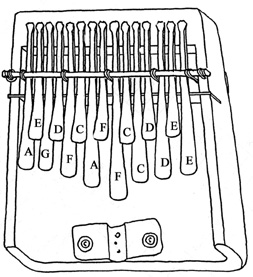
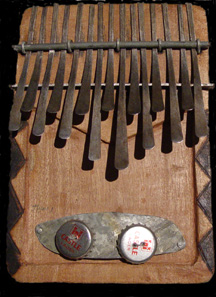
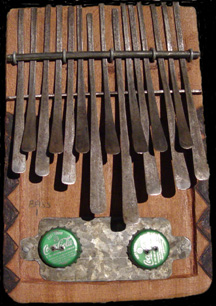
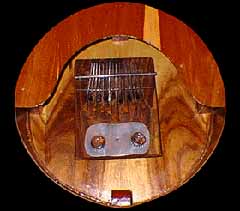
Karimba
(15 lamellae, High F): A smaller version of this instrument
with a similar 15-lamellae layout is known as ndimba
(on left above). Common tunings are high A, F, E, and
C but some instruments are made an octave lower (in low
A) as a bass karimba (see bottom photo on left,
made by Chaka Chawasarira). Some instruments come in Low
A tunings as well. Another version of this instrument was
made at the Kwanongoma College of Music with a circular
wooden resonator attached and is commonly known as nyunga
nyunga (usually tuned in High F, on bottom right).
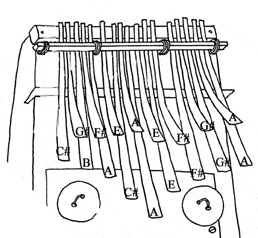
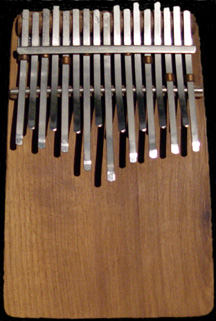
Karimba
(17 lamellae, High A): This instrument follows the tuning
pattern of a 15-lamellae instrument (in this case starting
a little higher on “A”) but includes 2 extra
lamellae on the upper and lower right side. African Musical
Instruments (Hugh Tracey model) makes a version of this
type. Some Shona ndimba have 17-lamellae but it
remains unclear as to whether the Hugh Tracey model was
based on a traditional 17-lamellae ndimba or not.
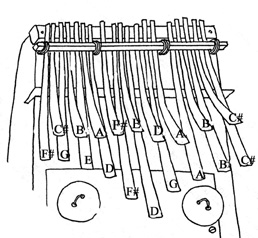
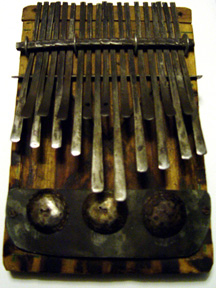
Karimba
(19 lamellae, High D): This instrument was developed by
Chaka Chawasarira and differs from the tuning pattern of
a 15-lamellae instrument by including 4 extra lamellae on
the upper and lower left and right sides. Sam Bvure also
makes these instruments now.
Mbira Dza Vadzimu

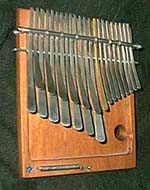
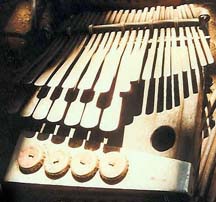
Mbira dza
vadzimu in Nyamaropa
(Western equivalent - Mixolydian, Medium G): Can have 22–27
lamellae. 22-lamellae instruments (on left) do not have
the left upper level 7th lamella. A 24-lamellae instrument
(on right) will have the left upper level 7th lamella while
extra lamellae beyond 23 simply continue on up the mode
on the right side. The diagram above is for a 24-lamellae
mbira dza vadzimu. Nyamaropa is the most common
tuning. Some use the term “Nhemamusasa”
for mbira with a Nyamaropa tuning. Arrows
in these diagrams show octave relationships.
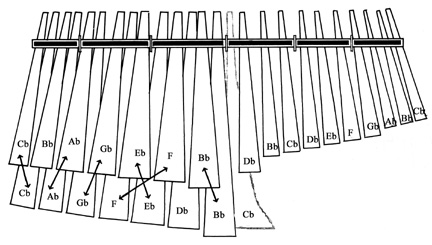
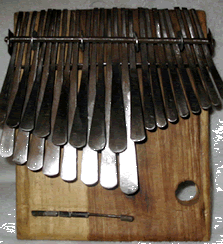
Mbira
in Gandanga or Mavembe
(Western equivalent - Phrygian, Medium Bb): Can have 22-27
lamellae with extra lamellae beyond 22 simply continuing
on up the right side but Gandanga tuning sometimes
also features an extra bass lamella. The extra bass lamella
may be present or it may not. If it is present, it can be
either on the right or left side of what is the lowest lamella
(in this diagram it is sketched in on the right side of
the lowest lamella but in the photo of a 25-lamellae instrument
the extra bass lamella is the 2nd on left on the bottom
row). While Gandanga tuned instruments can be High,
Medium, or Low tuned, typically they are Medium tuned. Furthermore,
a tuning by Forward Kwenda (coming to him in a dream) is
said to be Nemakonde (Low) when
the lamellae of a Dambatsoko tuned mbira dza
vadzimu are altered so that those on the left side
remain in Dambatsoko and while those the right
side are tuned in Gandanga. During a ceremony,
spirits told him to call this tuning “Nemakonde.”
However, analyses of recordings said to be in Nemakonde
tuning reveal a Low Gandanga tuning. Nemakonde
tuning is only played by Forward Kwenda. Lastly, it is really
only recordings from relatively recent times in gandanga
tuning that sound to Western ears as phrygian. The inventor
of gandanga tuning is said to be Sekuru Gora and his tuning
sounded more lydian to Western ears.
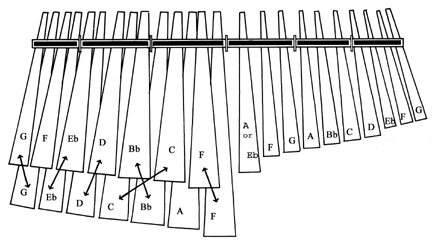

Mbira
in Dongonda also known as Nyamaropa
Dongonda or Njari Makonde
(Western equivalent - Mixolydian, Low F): Mbira
in Dongonda tuning feature the typically higher
lamellae of the right side of the instrument tuned down
an octave to be in unison with the upper lamellae on the
left side. The first key on the right side can be tuned
to either the flat 7th or the typical 3rd as is found on
regular Nyamaropa mbira. The photo is
of a 23 lamellae instrument.
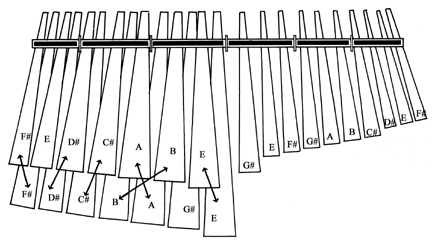
Mbira
in Dambatsoko also
known as Mahororo (Western equivalent
- Ionian, Low E): Can have 22–27 lamellae. 22-lamellae
instruments do not have the left upper level 7th lamella.
A 23-lamellae instrument will have the left upper level
7th lamella while extra lamellae beyond 23 simply continue
on up the mode on the right side. This tuning was developed
by the Mujuru clan for their ancestors. Most often the Mujuru
Dambatsoko tuning is simply Nyamaropa
tuning but when it is different, the difference is typically
a raised or “major” 7th in place of the lowered
7th. Apparently, only instruments made by a Mujuru clan
member can be truly called in “Dambatsoko”
tuning. Furthermore, such instruments can be tuned in a
variety of ways by the Mujuru clan and, despite the variety,
all may be referred to as “Dambatsoko.”
Dambatsoko mbira are often Low tuned.

Mbira
in Gandanga Dongonda
(Western equivalent - Phrygian, Medium Bb): Mbira
in Dongonda tuning feature the typically higher
lamellae of the right side of the instrument tuned down
an octave to match the upper lamellae range on the left
side. This tuning sometimes also features an extra bass
lamella. The extra bass lamella may be present or it may
not. If it is present, it can be either on the right or
left side of what is the lowest lamella (in this diagram
it is sketched in on the right side of the lowest lamella).
In Gandanga dongonda tuning, the first key of the
right side can be tuned to either the flat 7th or the typical
flat 3rd of a regular Gandanga tuned mbira.
The difference between a Gandanga
tuned mbira and a Gandanga Dongonda tuned
mbira is that the right side lamellae of a Gandanga
Dongonda mbira are tuned an octave lower than
are found on a Gandanga mbira.
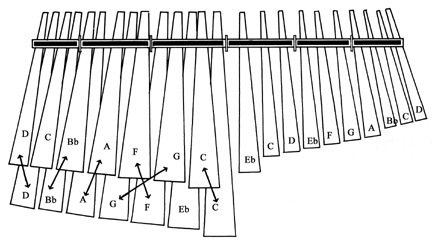
Mbira
in Katsanzaira (Western equivalent
- Dorian, High C): Mbira tuned in Katsanzaira
retain the same lamellae relationships as mbira
in Nyamaropa with the exception that the 3rd is
lowered to go with the lowered 7th in making the Western
equivalent of a Dorian mode. A tuning in a Low Dorian is
said to be in Samsengere or Nyuchi Samsengere.
The term Mazingizi (Low Dorian)
is sometimes used for a tuning one octave lower than Katsanzaira
(High Dorian).
Diagram for Saungweme
- coming soon
Mbira
in Saungweme (Western equivalent
- roughly whole tone scale, Medium A): Tuning of Rinos "Simboti"
Mukuwurirwa. A non-Western tuning that is close to a whole
tone scale (but some instrumenta have been found close to
a Lydian as well as Aeolian as far as the intervallic relationships
are concerned).

Mbira
in Manjengwa (Western equivalent
- roughly Lydian, in A above) = Tuning for some mbira
made by Fradreck Manjengwa - features
a raised 4th and a natural 7th.
Matepe (or Hera)

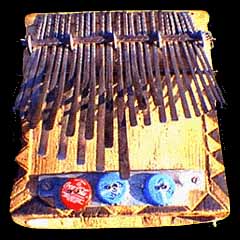
Matepe
in non-Western tuning: The tuning for matepe
(also known as hera) instruments differ between
players and are non-Western. The diagram offered above is
only meant to show what a Western musician might call "intervallic
relationships" but the relationships between the lamellae
and pitch names differ widely from strict Western intonation
(A=440). Lamellae above with a "U" indicate an
upper manual. One of the reasons for such differences in
"pitch" is that Western tunings typically center
on adjusting the fundamental of a pitch while some African
mbira tunings center on adjusting the overtones
of a lamella and not the fundamental, such as in Chaka Chawasarira's
25-lamellae matepe in the above diagram. To demonstrate
the individuality of this non-Western tuning, the note names
are given below with the plus or minus cents reading for
each lamella (along with its physical location on the instrument).
This tuning is not to be taken as an example of a typical
matepe tuning. Rather, this is an example of one
individual matepe maker's tuning.
Lower left starting from
center "F#" & ascending left: 8 lamellae
F# -5
cents
A -35 cents
B -12 cents
D +20 cents
E -5 cents
A +35 cents (octave higher, unison with
right upper "A")
B +20 cents (octave higher, unison with
right upper "B")
C +30 cents
Upper left starting from
"G" & ascending left: 5 lamellae
G +35
cents
C +30 cents
G# -15 cents (next octave up)
F# +15 cents (octave higher than lowest
lamella)
A +35 cents (unison with right upper "A")
Lower right starting from
"C" and ascending right: 10 lamellae
C +15
cents
D +10 cents
E
F# -10 cents
G +15 cents
A -10 cents
B -10 cents
C +40 cents
D +20 cents
E +30 cents
Upper right starting on "A" and ascending right:
2 lamellae
A +35
cents (unison with lower left "A" +35 cents)
B +20 cents (unison with lower "B"
+ 20 cents)
Mbira
dza VaNdau
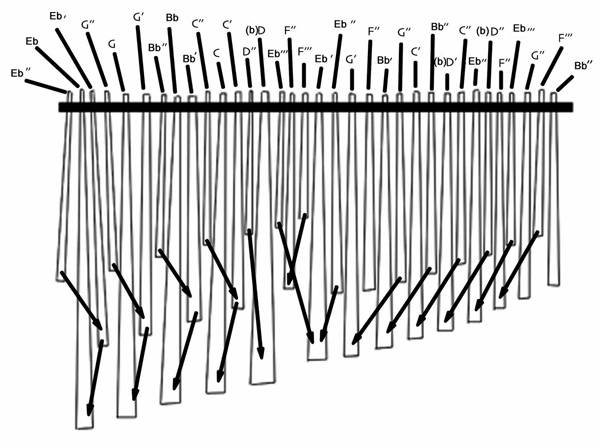
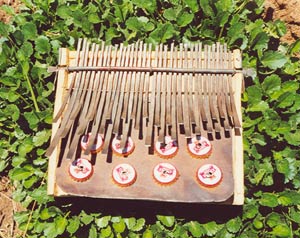
Mbira dza
VaNdau in hexatonic tuning, 34 lamellae. The
tuning diagram above is based on an instrument made by Zivanai
Khumbula from Tonhorai in Zimbabwe. These types of mbira
vary from maker to maker so the diagram above is only for
this particular instrument made by him. A feature of this
mbira's layout is that the lowest lamella is on
the left and they ascend to the right. The second and third
manuals are 2nd and 3rd octaves (some are in the 4th octave).
No mark after a pitch name = lowest octave, with one mark
= one octave up from there, 2 marks = 2 octaves up, and
3 marks = 3 octaves up (the 4th octave). The (b)D = a flat
D but not quite a Db. The pitch names here are just to give
an idea of the octave layouts and are not meant to be 440.
The basic hexatonic pitch inventory is Eb, F, G, B, C, D.
Njari
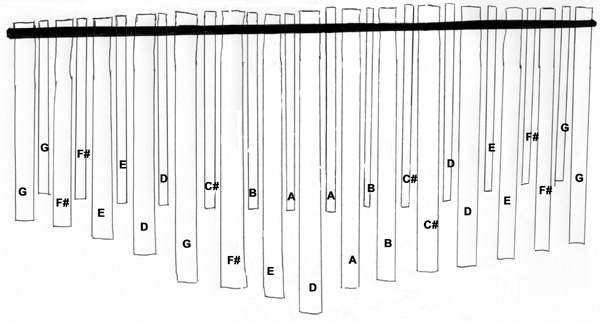

Njari
tuning, 29 lamellae. The tuning diagram for this njari is
based on an instrument made by Simon Mashoko. The pitch
names here are just to give an idea of the octave layouts
and are not meant to be 440. The upper manual pitches are
in the octave above those in the lower manual.
Other
Lamellaphones from Africa
Kadongo
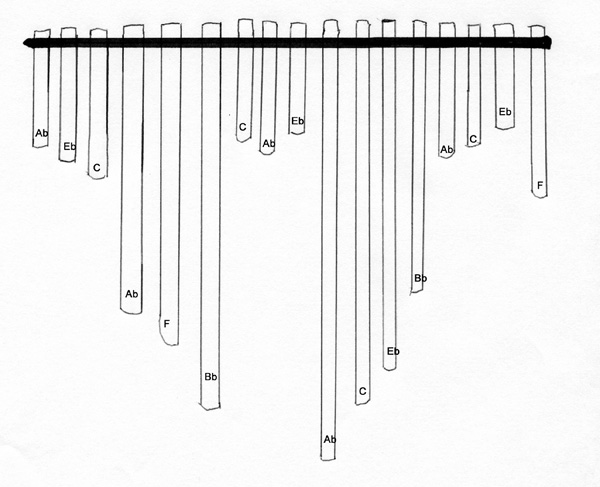
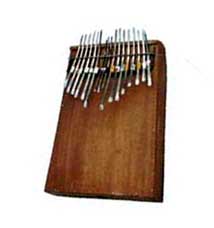
Kadongo
tuning from Uganda, played by Buganda People, 17 lamellae.
These instruments are available in various sizes and the
most standard tuning involves 10 lamellae (the outside 5
lamellae on each side). This model is actually referred
to as a 14 lamellae version as the middle 3 lamellae are
sympathetic and often not included when a lamellae count
is given. All of the Abs, Cs, and Ebs on the shortest lamellae
are in unison. The Abs, Bbs, and Fs are an octave apart
(longer lamellae are lower octave). The pitch names here
are just to give an idea of the octave layouts and are not
meant to be 440. "Akadongo" is sometimes
used for this instrument while the term "budongo"
is plural.
Likembe
Likembe
tuning from the Democratic Republic of Congo (formerly
Zaïre) of Titos Sompa from Brazzaville, 14 lamellae.

Chirimba
Chirimba
from Tanzania in non-Western pentatonic tuning:
This is the tuning that Dr. Hukwe Ubi Zawose (of the Wagogo
People of central Tanzania) used on his small 15-lamellae
chirimba, which is pentatonic but features non-Western
intervals. Note names and cents measurements are given below.
Start from lowest lamella
in center with right thumb and alternate hands to ascend:
G +19
cents
A +26 cents
B +6 cents
D +17 cents
F -9 cents
G +19 cents (octave higher)
A +26 cents
B +6 cents
D +17 cents
F -9 cents
G +19 cents (next octave up)
A +26 cents
B +6 cents
D +17 cents
F -9 cents
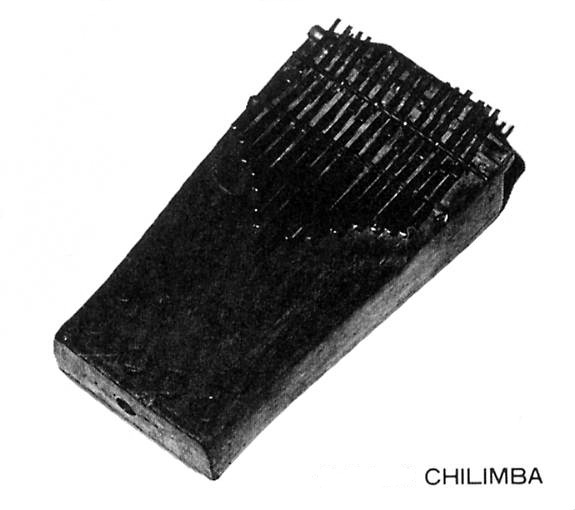
Special thanks for help in compiling
this information: B.
Michael Williams, Erica
Azim, Dan Pauli, Joel
Laviolette, Chaka Chawasarira, Forward
Kwenda, Claire
Jones, Solomon Murungu,
David Bellinger,
Anthony Perman, Titos
Sompa, and Nolan
Warden.
©2004 - N. Scott Robinson.
All rights reserved. |

